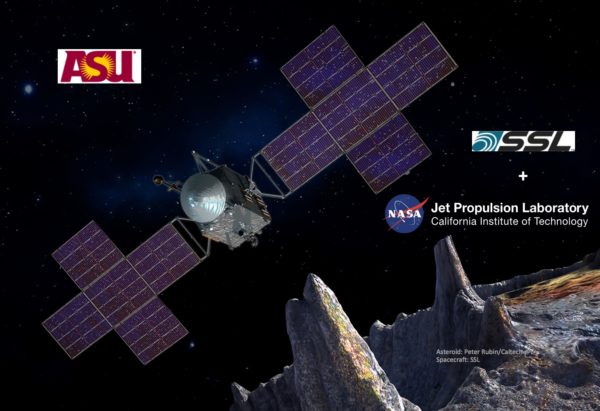October 4, 2017
Creating Psyche: Innovation as Team Sport
I have been working with Lindy for over four years as system architect for the Psyche mission concept. The idea for the Psyche mission appealed to me from the very beginning. The chance to explore a new type of metal world for the first time struck me as a classic mission of discovery, part of NASA’s long tradition of exploring new worlds and opening new frontiers.
I have worked on several projects at NASA’s Jet Propulsion Laboratory (JPL), including the Curiosity Mars Rover, and before I came to JPL I spent years working on Hall thrusters (a type of plasma thruster — see photo) at a time when they were first being adopting for commercial use. What this means is that for me, the Psyche mission is a perfect combination of exciting new science and innovative engineering using one of my favorite technologies (yes, I have a favorite technology): electric propulsion. Our propulsion system converts electricity into thrust by ionizing xenon gas and accelerating it across a magnetic field. This uses far less propellant than conventional rockets, which get their thrust from chemical reactions and are thus inefficient and impractical for this type of mission.

Electric Propulsion in Action! Test firing the SPT-140 Hall Thruster. Image credit: SSL
Taking the idea for Psyche and turning it into a viable mission concept took both effort and innovation, and it didn’t happen in a vacuum. Innovation is a team sport, combining scientists, engineers, designers, artists, writers, managers and others across multiple disciplines and multiple organizations. The team puts in this effort because they are passionate about exploring the solar system, they dream of flying a never-before-flown-mission, and they have, collectively, the skills and the vision to turn an idea into a developed mission concept.
JPL works hard to nurture new missions, and last February, I spoke at the Emerging Technologies (EmTech) conference in Singapore about the process by which we develop ideas into missions. Some highlights:
- NASA’s Discovery program has been exploring the solar system since the 1990’s with cost-capped missions led by Principal Investigators (PI’s), who compete to be part of the program.
- Some missions begin on a napkin. Some begin on a whiteboard. Psyche began in an email!
- To turn an idea into a testable hypothesis, and then into a feasible mission is a process that is both blue sky and collaborative by nature.
- JPL’s Innovation Foundry provides tools, methods and people to support this process.
- Psyche’s spacecraft is built around a unique partnership between JPL and Space Systems Loral (SSL) that brings together the strengths of both organizations and combines JPL’s deep space avionics and software with SSL’s commercial power and propulsion systems.
- In many ways, the selection process is like auditioning for a big Hollywood movie. You go through two rounds of audition, and if you win… you’re not famous yet! You just get the chance to make the movie. That’s where Psyche is now: we get the chance to build the mission.
- Psyche is a mission of exploration, and a model for future partnerships between government and industry.
It truly is a privilege to work with such a remarkable team to build and fly this mission!
View the whole talk on YouTube: https://youtu.be/sDLmqQXk3Zs (or click the video at the top of this page!)

Psyche is a unique partnership that brings together the strengths of JPL and SSL. Image Credit: SSL/ASU/Peter Rubin

